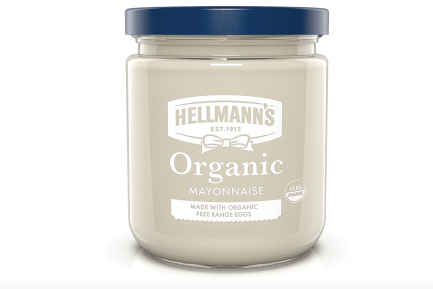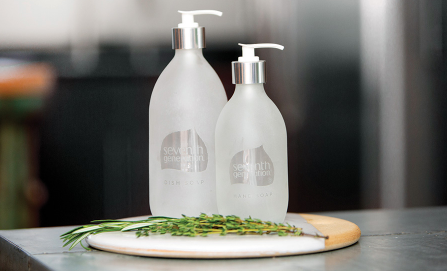
Loop containers will feature the How2Recycle label to simplify on-package recycling instructions for consumers.

Loop refillable deodorant packaging is designed to last at least 100 cycles or about eight years.

By 2025, all Unilever plastic packaging will be reusable, recyclable or compostable and 25% will come from recycled plastic.
Our single-use disposable packaging world is about to change. And this time the change is being fueled by consumer demand. Witness the backlash against plastics with the ubiquitous refillable metal water bottle in everyone’s hands, the ban of single-use plastic bags in New York, California (and elsewhere), and the focus on how our oceans are overflowing — not with fish, but with tons of plastic. Efforts to recycle are also proving too difficult and costly to be effective and don’t address the root cause of the issue. But, aside from single-use packaging being bad for the environment, it simply can’t deliver on truly great and entirely new brand experiences unconstrained by the cost of goods (i.e. fretting over fractions of pennies in material costs).
With consumer acceptance growing, we can now view packaging as durable rather than disposable, and offer solutions that are truly sustainable while delivering usage experiences never before possible. One example is Loop, the zero-waste platform announced at the World Economic Forum, formed by a coalition of major consumer product manufacturers including Procter & Gamble, Nestle, PepsiCo, Unilever, etc. With pilot programs rolling out in New York this past May, the circular shopping platform features products in durable packages that are delivered, consumed, and then returned back to the manufacturer to be cleaned and refilled, and sent out again.
This major shift in ownership of the package from the consumer to the brand is a ticket to unfettered imagination in consumer experience and sustainability. The package essentially becomes an asset and can be viewed and designed as a device. This opens the door to a myriad of opportunities and innovation, unlocking technology that can change the experience of the user in ways never before possible. Brands can rethink what their package does and how the consumer uses it, such as a pill package that reminds you when to take or reorder pills, detect when a food has expired (say goodbye to the smell test), automatically order more product when its running low, or self-seal to insure freshness.
While initial package costs are more, with each reuse, the cost splits in half and, importantly, the consumer is not throwing it away. TerraCycle, the parent company of Loop, calculated the total impact of the packaging and found that it’s between 50-75% better for the environment than conventional alternatives.
Jasmin Druffner, (durable packaging developer, Loop Global), acknowledges, “Loop is a groundbreaking platform that goes against the grain. But, it gives brands an opportunity to rethink how consumers view them through their packaging.” (See sidebar).
Whereas it used to be convenience and ease of use that dominated the landscape, today consumers are more than happy to bring their own reusable bags to shop while demanding that Starbucks get rid of single-use plastic straws.
Here are three ways that brands and packaging teams can approach this successfully:
Inspire your team with the possibilities. This is the chance to help them imagine an entirely new consumer experience is possible. What can be done for consumers to change their experience with the brand and differentiate it from the competition? For the Loop initiative, Häagen-Dazs has developed a refillable stainless steel ice cream tub that delivers a better experience by keeping the product colder longer. According to Tommy See Tho, packaging and design manager at Nestlé, “The feature resonates well with test consumers and contributes to the “freshness” of the product.” (See sidebar.)
The initial launch will reach thousands of consumers in New York and Paris. Reusable packages have the potential to allow technological features that make them more “intelligent,” able to anticipate user needs, and many other things we didn’t imagine possible. Think of it as a chance to deliver something to consumers that is really important to them — even an experience tailored to their unique lifestyle.
Quantify the result to insure leadership support. Make sure your team has created real value for your consumer, and not just a gimmick. Usability studies and in home usage tests provide a window into the real world. Also, collecting usage data directly from the package can unlock quantitative evaluation tools only dreamed of in the past! Think of this as designing an asset, so that it can be robustly engineered.
Identify suppliers early on to insure best implementation. Many existing packaging components are composed of plastics that may be difficult to clean and reuse. New global manufacturing partners may need to be part of an innovative solution. Finding the right partner and utilizing the right technology is key. Getting them involved early in the design process ensures a smooth and quick transition into production.
Transitioning from a use and toss packaging model to a durable package shouldn’t be seen as difficult or expensive but instead an opportunity for your team to innovate at a level never before seen in your category.
The durable packaging movement is an opportunity for packaging professionals everywhere to be part of a truly sustainable product/package model that can have a tremendous impact in the world. Get out and inspire your teams to be a part of it!
(Source:packagingstrategies)















 沪公网安备 31010702006282号
沪公网安备 31010702006282号